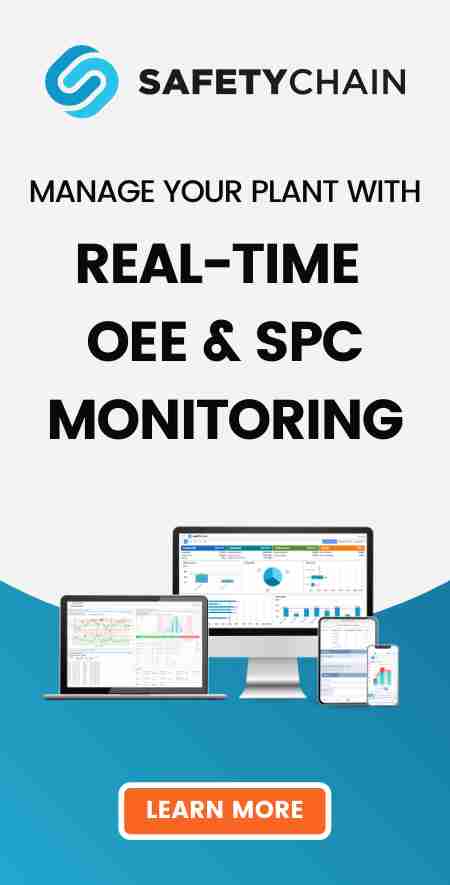Editor’s note: This is part one of a four-part series on understanding and implementing overall equipment effectiveness strategy. This series is sponsored by SafetyChain Software.
For many food manufactures, the concept of measuring overall equipment effectiveness, aka OEE, is a common strategy to track output efficiency. However, if not fully understood or analyzed properly, companies can be suffering significant economic losses due to operational inefficiencies that are hidden in the data.
“OEE is one of the best metrics for tracking the efficiency of a plant by benchmarking progress, identifying losses and improving the productivity of manufacturing equipment,” says Dr. Clara Gavriliuc, vice president of Data Analytics for SafetyChain Software. “All of these factors contribute to huge economic losses when negatively impacted, making it essential for companies to implement effective OEE strategy that takes all operation data into account.”
There are three areas of data that contribute to OEE:
Is the machine operating or not? Availability loss includes output reductions due to downtime, whether that be from breakdowns, calibrations, routine maintenance, product changeover and even the process warmup period.
“This is the most popular data point for people to analyze because it is easy to see the economic impact,” says Dr. Gavriliuc. “For example, say you charge $1 for a product and can make 60 of them in one hour. If your machine is broken down for one hour, you can easily see that the breakdown cost you $60 in product loss.”
Performance
How fast is the machine running? This can be caused by machines not equipped to handle a certain product and aged or unmaintained, uncalibrated equipment and even inadequate personnel training.
“This is where we start to see the opportunity to improve equipment efficiency through hidden data,” says Dr. Gavriliuc. “You need to look at how many products are being produced per an ideal cycle time and if there is opportunity to cost-effectively increase the productivity per minute whether it be calibration or upgrading the machine. This is valuable data for justifying a new piece of equipment.”
Quality
How many products are meeting specs? Quality issues are leading culprits of product and time resource waste.
“Machine availability and performance output data can be exceptional, however, a company’s OEE and income will suffer if the quality of the product is leading to rejections – and therefore waste and decreased profits,” explains Dr. Gavriliuc. “Not only does the quantity of rejection need to be analyzed, but more importantly, reason. Identifying the root cause will reduce chronic and long-term quality issues.”
Calculating OEE
OEE = Availability x Performance x Quality. The final OEE figure is represented as a percentage of efficiency from 0-100.
In the industry, there are five levels of OEE benchmarks:
- 0-25% = Unacceptable
- 26-55% = Needs improvement
- 56-70% = Industry average
- 71-85% = High performance
- 86-100% = World-class
“Food manufacturers wanting to set a realistic OEE goal should be striving to be at 80 percent. Anything under that is leaving a lot of profit potential on the table,” she says.
OEE scenario
To calculate OEE, go back to Dr. Gavriliuc’s example of a line producing 60 products in an hour worth $1 each in profit. In this plant, a shift is 8 hours, therefore, the expected output is 480 units. It costs this line $100 per shift to run.
Due to a product formulation changeover, the machine is only operating for 7 hours. Availability: 7hrs x 60 units/hr = 420 units per shift
However, the machine is running slower than usual and is only producing 50 units per hour. Performance: 7hrs x 50 units/hr = 350 units per shift. Due to a scale needing to be calibrated, 25 units were underweight and did not meet spec. This means the final shift output was 325 units.
Quality: 325 units per shift. This means: Availability (7/8hrs = 87.5%) x Performance (420/480 units = 87.5%) x Quality (325/350 units = 92.8%) = 71% OEE.
On a good day at 100% OEE, it only cost the company $0.21 per unit to run the line ($100/480). However, on this day when only 325 units were produced, it cost the company an additional $0.31 per unit.
The numbers in this scenario are scaled back for simplicity. When put into practice in food plants producing thousands of units per day, the cost of inefficiency quickly adds up to thousands of dollars.
The danger of not fully analyzing data
According to Dr. Gavriliuc, it is common for plants to calculate OEE by simply dividing the actual units produced per shift by the total output potential.
“This is not a very accurate way to configure OEE because it offers a limited view into output efficiency,” concludes Dr. Gavriliuc. “To truly get on top of inefficiencies, to get a plant to optimum OEE, digging through the data of each OEE component to find the root causes of these issues is a must.”
In part two, Dr. Gavriliuc explains how to audit OEE data to identify the biggest pain points.
 For optimum data collection and analysis, the opportunity lies with real-time plant performance software that is capable of tracking anything from downtime to how long it takes ovens to get to the right temperatures, to packaging.
For optimum data collection and analysis, the opportunity lies with real-time plant performance software that is capable of tracking anything from downtime to how long it takes ovens to get to the right temperatures, to packaging.

 Editor’s note: This is the fourth installment of a four-part series on electronic record keeping enhancing companies’ food safety efforts. The series is sponsored by PAR Technologies.
Editor’s note: This is the fourth installment of a four-part series on electronic record keeping enhancing companies’ food safety efforts. The series is sponsored by PAR Technologies. 